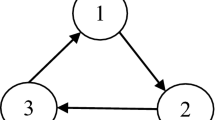Abstract
We consider the problem of determining the optimal node interception strategy during influence propagation over a (directed) network \(G=(V,A)\). More specifically, this work aims to find an interception set \(D \subseteq V\) such that the influence spread over the remaining network \(G \backslash D\) under the linear threshold diffusion model is minimized. We prove its NP-hardness, even in the case when G is an undirected graph with unit edge weights. An exact algorithm based on integer linear programming and delayed constraint generation is proposed to determine the most critical nodes in the influence propagation process. Additionally, we investigate the technique of lifting inequalities of minimal activation sets. Experiments on the connected Watts-Strogatz small-world networks and real-world networks are also conducted to validate the effectiveness of our methodology.




Similar content being viewed by others
Data availability
The data used in this paper have been previously detailed within the document. Additional data will be made available on reasonable request.
References
Kempe, D., Kleinberg, J., Tardos, É.: Maximizing the spread of influence through a social network. In: Proceedings of the Ninth ACM SIGKDD International Conference on Knowledge Discovery and Data Mining, pp. 137–146 (2003)
Li, Y., Fan, J., Wang, Y., Tan, K.-L.: Influence maximization on social graphs: A survey. IEEE Trans. Knowl. Data Eng. 30(10), 1852–1872 (2018)
Acemoglu, D., Ozdaglar, A., Yildiz, E.: Diffusion of innovations in social networks. In: 2011 50th IEEE Conference on Decision and Control and European Control Conference, pp. 2329–2334 (2011). IEEE
Fazeli, A., Ajorlou, A., Jadbabaie, A.: Competitive diffusion in social networks: quality or seeding? IEEE Trans. Control Network Syst. 4(3), 665–675 (2016)
Budak, C., Agrawal, D., El Abbadi, A.: Limiting the spread of misinformation in social networks. In: Proceedings of the 20th International Conference on World Wide Web, pp. 665–674 (2011)
Cheng, C.-H., Kuo, Y.-H., Zhou, Z.: Outbreak minimization vs influence maximization: an optimization framework. BMC Med. Inform. Decis. Mak. 20(1), 1–13 (2020)
Yao, S., Fan, N., Hu, J.: Modeling the spread of infectious diseases through influence maximization. Optim. Lett. 16(5), 1563–1586 (2022)
Coró, F., D’angelo, G., Velaj, Y.: Link recommendation for social influence maximization. ACM Trans. Know. Disc. Data (TKDD) 15(6), 1–23 (2021)
Khalil, E., Dilkina, B., Song, L.: Cuttingedge: influence minimization in networks. In: Proceedings of Workshop on Frontiers of Network Analysis: Methods, Models, and Applications at NIPS, pp. 1–13 (2013)
Kimura, M., Saito, K., Motoda, H.: Minimizing the spread of contamination by blocking links in a network. In: Aaai, vol. 8, pp. 1175–1180 (2008)
Charkhgard, H., Subramanian, V., Silva, W., Das, T.K.: An integer linear programming formulation for removing nodes in a network to minimize the spread of influenza virus infections. Discret. Optim. 30, 144–167 (2018)
Wang, S., Zhao, X., Chen, Y., Li, Z., Zhang, K., Xia, J.: Negative influence minimizing by blocking nodes in social networks. In: Proceedings of the 17th AAAI Conference on Late-Breaking Developments in the Field of Artificial Intelligence, pp. 134–136 (2013)
Nandi, A.K., Medal, H.R.: Methods for removing links in a network to minimize the spread of infections. Comput. Operat. Res. 69, 10–24 (2016)
Gillen, C.P., Veremyev, A., Prokopyev, O.A., Pasiliao, E.L.: Critical arcs detection in influence networks. Networks 71(4), 412–431 (2018)
Yang, L., Li, Z., Giua, A.: Containment of rumor spread in complex social networks. Inf. Sci. 506, 113–130 (2020)
Yang, L.: Influence minimization and rumor containment in social networks. PhD thesis, Aix-Marseille (2019)
Lalou, M., Tahraoui, M.A., Kheddouci, H.: The critical node detection problem in networks: a survey. Comput. Sci. Rev. 28, 92–117 (2018)
Lewis, J.M., Yannakakis, M.: The node-deletion problem for hereditary properties is np-complete. J. Comput. Syst. Sci. 20(2), 219–230 (1980)
Yannakakis, M.: Node-deletion problems on bipartite graphs. SIAM J. Comput. 10(2), 310–327 (1981)
Xie, J., Zhang, F., Wang, K., Lin, X., Zhang, W.: Minimizing the influence of misinformation via vertex blocking. In: 2023 IEEE 39th International Conference on Data Engineering (ICDE), pp. 789–801. IEEE Computer Society, Los Alamitos, CA, USA (2023). https://doi.org/10.1109/ICDE55515.2023.00066
Fischetti, M., Kahr, M., Leitner, M., Monaci, M., Ruthmair, M.: Least cost influence propagation in (social) networks. Math. Program. 170(1), 293–325 (2018)
Nannicini, G., Sartor, G., Traversi, E., Wolfler Calvo, R.: An exact algorithm for robust influence maximization. Math. Program. 183(1), 419–453 (2020)
Gu, Z., Nemhauser, G.L., Savelsbergh, M.W.: Lifted flow cover inequalities for mixed 0–1 integer programs. Math. Program. 85(3), 439–467 (1999)
Zeng, B., Richard, J.-P.P.: Sequence independent lifting for 0–1 knapsack problems with disjoint cardinality constraints. School of Industrial Engineering, Purdue University, West Lafayette (2006)
Dey, S.S., Richard, J.-P.: Linear-programming-based lifting and its application to primal cutting-plane algorithms. INFORMS J. Comput. 21(1), 137–150 (2009)
Leskovec, J., Krevl, A.: SNAP Datasets: stanford large network dataset collection. http://snap.stanford.edu/data (2014)
Rossi, R.A., Ahmed, N.K.: The network data repository with interactive graph analytics and visualization. In: AAAI (2015). https://networkrepository.com/
Watts, D.J., Strogatz, S.H.: Collective dynamics of ‘small-world’networks. Nature 393(6684), 440–442 (1998)
Leskovec, J., Kleinberg, J., Faloutsos, C.: Graph evolution: densification and shrinking diameters. ACM Trans. Know. Disc. Data (TKDD) 1(1), 2 (2007)
Rozemberczki, B., Sarkar, R.: Characteristic functions on graphs: birds of a feather, from statistical descriptors to parametric models. In: Proceedings of the 29th ACM International Conference on Information and Knowledge Management (CIKM ’20), pp. 1325–1334 (2020). ACM
Boguná, M., Pastor-Satorras, R., Díaz-Guilera, A., Arenas, A.: Models of social networks based on social distance attachment. Phys. Rev. E 70(5), 056122 (2004)
Author information
Authors and Affiliations
Corresponding author
Additional information
Publisher's Note
Springer Nature remains neutral with regard to jurisdictional claims in published maps and institutional affiliations.
Rights and permissions
Springer Nature or its licensor (e.g. a society or other partner) holds exclusive rights to this article under a publishing agreement with the author(s) or other rightsholder(s); author self-archiving of the accepted manuscript version of this article is solely governed by the terms of such publishing agreement and applicable law.
About this article
Cite this article
Yao, S., Fan, N. & Krokhmal, P. Minimizing the influence spread over a network through node interception. Optim Lett (2024). https://doi.org/10.1007/s11590-024-02117-w
Received:
Accepted:
Published:
DOI: https://doi.org/10.1007/s11590-024-02117-w




